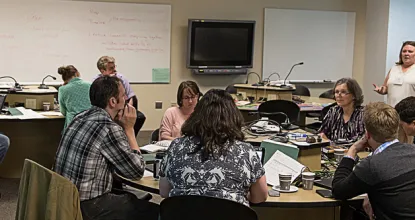Why do you need to participate in peer evaluation?
Evaluation of an instructor by their peers has become an integral part of teaching at a university. This results from several sources. Motivations can be intrinsic as instructors seek to improve their teaching, but they can also be extrinsic. Peer evaluation can be beneficial for your long-term teaching goals and a necessity to your professional advancement. Similarly, service as an observer is important for the professional participation of faculty and allows the faculty to maintain ownership of the quality and content of the curriculum.
- Peer evaluation is specified by faculty contract
- Section 5.4 of the AAUP Master Agreement under Faculty Evaluation
- Article 12 of the NMUFA Agreement
- Improves your teaching (Peer Review of Teaching)
What is Peer Evaluation of Teaching?
Peer Evaluation of Teaching consists of the review of teaching performance by colleagues, usually in the same or a similar discipline, with the purpose of assessing and improving the quality of teaching.
Peer review puts faculty in charge of the quality of their teaching. Peer collaboration and review enables instructors to actively improve the quality of teaching in their own classroom and in their department. “Excellent teachers ...set out to inquire into their own practice, identifying key issues they want to pursue, posing questions for themselves, exploring alternatives and taking risks, and doing all of this in the company of peers who can offer critique and support. These are the habits of mind we expect, after all, in scholarly work, and we should expect them in teaching as much as in research.” [England 1996] It is the responsibility of professional teachers to monitor the quality of the teaching in their departments and institutions.
Peer Evaluation of Teaching is used in many contexts.
- General teaching improvement for current instructors (e.g. delivery, student engagement, content organization)
- Hiring (e.g. teaching presentations/ job talks).
- Mentoring of junior instructors (new faculty, adjuncts, graduate assistants).
- Promotion or advancement decisions
- Award of sabbaticals
- Merit awards (e.g. Excellence in Teaching, Merit Awards)
What is the purpose of Peer Evaluation of Teaching?
Review of a faculty member’s teaching by his/her peers has two distinct purposes.
Formative reviews are intended to develop or improve teaching. Formative reviews should be intended for the personal use of the observed instructor. Regular conversation among colleagues about teaching should be a hallmark of every department or school’s culture, and formative peer review processes for pre-tenure, non-tenure-track, and tenured faculty should be designed in every department or school to suit that culture
Summative, or evaluative, reviews are intended for judgments in increment, contract renewal, or promotion processes.
What are the components of Evaluation of Teaching?
- Peer Evaluation - Peer evaluation has multiple components
- In-class Observation (link to information on in-class observation)
- Or Online Review (contact the CTL to have a 'Guest Lecturer' added to your course)
- Course Material Review (link to something)
- In-class Observation (link to information on in-class observation)
- Student ratings - Student ratings are often reviewed as evidence of teaching, but they should not be viewed in isolation. Student ratings can often be useful for information of how students respond personally to their instructor, but students are not qualified to assess content knowledge or modality of instruction.
- Ongoing evaluation - Peer review of teaching should not be considered to be a single visitation to a course, but rather a longitudinal process in which there is a repeated conversation and reflection by the instructor with input from peers and students.
What is the role of the Department in Peer Evaluation?
For Peer Evaluation to be effective and fair, it needs to link to an agreed-upon process of evaluation. This should be developed within the context of the department as well as the instructor contract.
Some of the questions that should be answered by the department include:
- Who gets evaluated and when?
- What standards will be used for effective teaching?
- Will different standards be used for different instructor ranks (e.g. teaching assistants, adjuncts, etc.)
- Will different standards be used for different types of teaching (laboratories, clinical settings, studio courses, etc)
- How will different teaching approaches be reviewed (e.g. lecture, active learning, case based, etc.)
- How will evaluation of content vs delivery and course design be handled?
What resources are out there to work on peer evaluation of teaching?
There are many resources available for those interested in peer evaluation of teaching. Below are a few of the many published resources. In addition, you will find many resources online posted by institutions that are engaged in reform of their peer-review processes.
Peer Review of Teaching: A Sourcebook (2007) by Nancy Van Note Chism. An excellent overview of the issues associated with peer review of teaching. This book also includes many templates for review forms for many different settings and with different philosophical approaches. A copy is available in the CTL for your use.
Using peer review to foster good teaching (2008) S. Samson & D. McCrea Reference Services Review. 36(1):61-70. http://www.emeraldinsight.com/doi/abs/10.1108/00907320810852032
Peer observation of teaching as a faculty development tool (2012) P.B. Sullivan, A. Buckle, G. Nicky, S.H. Atkinson. BMC Medical Education. 12:26 http://www.biomedcentral.com/1472-6920/12/26
A qualitative review of literature on peer review of teaching in higher education: An application of the SWOT framework. 2014. S. Thomas, QT Chie, M. Abraham, S.J. Raj, L.-S. Beh. Review of Educational Research 84:112. http://rer.sagepub.com/content/84/1/112
Development of a peer teaching-assessment program and a peer observation and evaluation tool. 2008. American Journal of Pharmaceutical Education. 72(6): article 147. https://www.ncbi.nlm.nih.gov/pmc/articles/PMC2661155/
